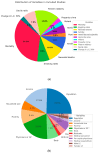Measuring Health Inequalities Using the Robin Hood Index: A Systematic Review with Meta-Analysis
- PMID: 40700107
- PMCID: PMC12285989
- DOI: 10.3390/epidemiologia6030035
Measuring Health Inequalities Using the Robin Hood Index: A Systematic Review with Meta-Analysis
Abstract
Background/Objectives: Although the Robin Hood Index (RHI) is increasingly used to quantify geographic health inequality and guide resource redistribution, empirical evidence on whether higher physician density reduces RHI-measured inequality remains limited. This study systematically reviews and meta-analyzes RHI-based research to assess the association between physician distribution and health inequalities. Methods: We conducted a systematic review and meta-analysis of studies using the RHI to evaluate health inequalities, without restrictions on country or publication date. Following PRISMA 2020 guidelines and registered in PROSPERO (CRD42024496486), we searched PubMed, Scopus, and OpenGrey literature, extracted data on physician density and RHI outcomes, and conducted a meta-analysis. Odds ratios (ORs), ln(OR), and 95% confidence intervals (CIs) were calculated, and risk of bias was assessed using the Robvis tool. Results: Seventeen studies covering 720 regions and 1.07 billion individuals were included. Three clusters emerged: physician redistribution (10 studies), poverty-mortality associations (six studies), and systematic reviews (one study). Physician redistribution was strongly associated with increased inequality and policy attention (r = 0.73; p = 0.0038). Meta-analysis of eight redistribution studies yielded a pooled OR of 1.24 (95% CI: 0.54-2.86), consistent in sensitivity analysis (OR = 1.26; 95% CI: 0.56-2.89). Poverty-mortality studies also showed a correlation with the number of variables considered (r = 0.59; p = 0.022). Conclusions: A greater physician supply is associated with increased health inequalities, with statistical support but limited certainty. Methodological heterogeneity in RHI-based studies constrains comparability. Standardized methodologies and broader analytic models are needed to inform research and guide health policy.
Keywords: general practitioners; health inequalities; indexes; resource allocation.
Conflict of interest statement
The authors declare no conflicts of interest.
Figures




Similar articles
-
Falls prevention interventions for community-dwelling older adults: systematic review and meta-analysis of benefits, harms, and patient values and preferences.Syst Rev. 2024 Nov 26;13(1):289. doi: 10.1186/s13643-024-02681-3. Syst Rev. 2024. PMID: 39593159 Free PMC article.
-
Systemic pharmacological treatments for chronic plaque psoriasis: a network meta-analysis.Cochrane Database Syst Rev. 2021 Apr 19;4(4):CD011535. doi: 10.1002/14651858.CD011535.pub4. Cochrane Database Syst Rev. 2021. Update in: Cochrane Database Syst Rev. 2022 May 23;5:CD011535. doi: 10.1002/14651858.CD011535.pub5. PMID: 33871055 Free PMC article. Updated.
-
Drugs for preventing postoperative nausea and vomiting in adults after general anaesthesia: a network meta-analysis.Cochrane Database Syst Rev. 2020 Oct 19;10(10):CD012859. doi: 10.1002/14651858.CD012859.pub2. Cochrane Database Syst Rev. 2020. PMID: 33075160 Free PMC article.
-
Healthcare outcomes assessed with observational study designs compared with those assessed in randomized trials.Cochrane Database Syst Rev. 2014 Apr 29;2014(4):MR000034. doi: 10.1002/14651858.MR000034.pub2. Cochrane Database Syst Rev. 2014. Update in: Cochrane Database Syst Rev. 2024 Jan 4;1:MR000034. doi: 10.1002/14651858.MR000034.pub3. PMID: 24782322 Free PMC article. Updated.
-
Prevention of self-harm and suicide in young people up to the age of 25 in education settings.Cochrane Database Syst Rev. 2024 Dec 20;12(12):CD013844. doi: 10.1002/14651858.CD013844.pub2. Cochrane Database Syst Rev. 2024. PMID: 39704320
References
Publication types
LinkOut - more resources
Full Text Sources

